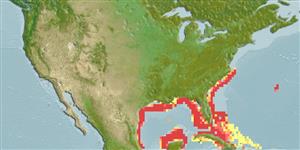>
Lophiiformes (Anglerfishes) >
Ogcocephalidae (Batfishes)
Etymology: Ogcocephalus: Greek, ogkos, ou = hook, curvature (Ref. 45335); corniger: From the long, upturned rostrum (corniger = horn-bearer) (Ref. 40824).
Environment: milieu / climate zone / depth range / distribution range
Sinh thái học
Biển gần đáy; Mức độ sâu 29 - 230 m (Ref. 40824). Subtropical; 37°N - 20°N
Western Atlantic: North Carolina and northern Gulf of Mexico in USA to southern Bahamas.
Bộ gần gũi / Khối lượng (Trọng lượng) / Age
Maturity: Lm ? range ? - ? cm
Max length : 23.0 cm TL con đực/không giới tính; (Ref. 7251)
Short description
Khóa để định loại | Hình thái học | Sinh trắc học
Evenly covered by closely set pale spots on a darker background. Subopercular lateral-line scales usually 5-7. Differs from pumilus in having larger body size and fleshy pads on the ventral tips of the pectoral rays (absent in pumilus) (Ref. 40824).
Found typically on sandy bottoms (Ref. 27549).
Life cycle and mating behavior
Maturities | Sự tái sinh sản | Spawnings | Egg(s) | Fecundities | Ấu trùng
Bradbury, M.G., 1980. A revision of the fish genus Ogcocephalus with descriptions of new species from the western Atlantic Ocean (Ogcocephalidae: Lophiiformes). Proc. Calif. Acad. Sci. 42(7):229-285. (Ref. 40824)
IUCN Red List Status (Ref. 130435)
Threat to humans
Harmless
Human uses
Các công cụ
Special reports
Download XML
Các nguồn internet
Estimates based on models
Preferred temperature (Ref.
123201): 18.3 - 27.4, mean 23.5 °C (based on 69 cells).
Phylogenetic diversity index (Ref.
82804): PD
50 = 0.5001 [Uniqueness, from 0.5 = low to 2.0 = high].
Bayesian length-weight: a=0.02291 (0.00925 - 0.05675), b=2.94 (2.72 - 3.16), in cm total length, based on LWR estimates for this (Sub)family-body shape (Ref.
93245).
Mức dinh dưỡng (Ref.
69278): 3.4 ±0.6 se; based on size and trophs of closest relatives
Thích nghi nhanh (Ref.
120179): Trung bình, thời gian nhân đôi của chủng quần tối thiểu là 1.4 - 4.4 năm (Preliminary K or Fecundity.).
Fishing Vulnerability (Ref.
59153): Low vulnerability (13 of 100).
